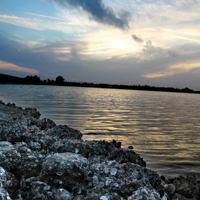 O’Bryan’s curious flip-flop on fertilizer regulation
O’Bryan’s curious flip-flop on fertilizer regulation
STORY BY STEVEN M. THOMAS, (Week of June 7, 2012)
Commissioner Peter O’Bryan has emerged recently as a determined opponent of a county ordinance to protect the Indian River Lagoon from poisonous fertilizer runoff that is killing sea grass, fish and dolphins.
His stance on the Commission is in direct opposition to a resolution he supported last fall as a member of the Treasure Coast Council of Local Governments, a body where he serves as vice chairman.
That resolution, dated Sept. 7, 2011, says “the impairment of the Indian River Lagoon . . . is caused by excessive nutrients” that come from fertilizer runoff. It goes on to encourage “counties, cities and municipalities to adopt their own fertilizer ordinances” to help stop an ecological crisis scientists say is looming.
The Council, composed of officials representing 20 governmental entities along the lagoon, stated “such adoption furthers public health, safety and general welfare of the residents and citizens of our four county area, as well as ensures we are acting responsibly as overseers of our limited natural resources and [being] respectful of future generations.”
When first asked if he had supported the resolution, O’ Bryan said he could not remember. Later he said he probably had supported it. Two other members of the Council confirm that he did.
“Peter O’Bryan supported the resolution,” said Sewall’s Point Mayor Jacqui Thurlow-Lippisch, who was Chairperson of the Council in September.
“Oh, yes. Peter supported it,” said current Council Chairperson and Sebastian City Council member Richard Gilmore. “I believe support was unanimous.”
“We said in our resolution that every member of the council would bring the idea of an ordinance before their commission,” said Thurlow-Lippisch.
The issue of fertilizer regulation heated up in Indian River County last year after ORCA – the Ocean Research and Conservation Association – mapped high levels of nitrogen pollution between the Barber Bridge and 17th Street Causeway.
The results of that study set off alarm bells for residents and politicians across the county and the cities of Vero Beach, Sebastian and Indian River Shores have since passed fertilizer regulations to help protect the estuary that Vero Mayor Pilar Turner said contributes $800 million annually to the county economy.
Fertilizer contains nitrates and phosphates that feed grass and help it grow. It is widely and sometimes indiscriminately applied by homeowners, lawn care professionals and workers at golf courses and parks. When fertilizer is over-applied and during rainstorms, dissolved nitrogen and phosphorous run off lawns and fields directly into the lagoon or into gutters, sewers and canals that lead to the lagoon.
The chemicals also enter waterways when grass clippings that have sucked up the organic chemicals are swept or hosed into sewers and ditches.
The runoff and clippings cause something called nutrient overload in the waters where Indian River County residents and visitors boat, fish, swim and delight in wildlife. Instead of feeding lawns, the nitrogen and phosphorous feed the growth of algae that consumes oxygen and makes lagoon water murky and slimy, cutting off sunlight to sea grass and starting a domino effect of ecological degradation.
Despite his support of the Treasure Coast Council of Local Governments’ resolution and his commitment to encourage adoption of a fertilizer ordinance here, O’Bryan said he is against an IRC ordinance because he thinks it would be unenforceable and because the thinks education is better than regulation.
“I only supported the resolution because those counties down there have problems with fertilizer discharges that we don’t have,” O’Bryan said.
Mayor Thurlow-Lippisch disagrees with O’Bryan’s contention that Indian River County’s interests and actions are isolated from those of other communities along the lagoon.
“We are all connected,” she says. “I am Sewall's point but the water from Indian River County is flowing past our peninsula.”
She also takes issue with the idea that public education promoting best practices for fertilizer use is sufficient without regulation.
“The only way to bring consciousness to the situation is to pass an ordinance. Otherwise people will keep doing what they have been doing since after World War II.”
O’Bryan has discussed the idea of fertilizer education initiatives with area environmental organizations but no new programs have been created so far.
Scientists familiar with the lagoon strongly support regulation.
“Fertilizer regulation is needed,” said Richard Baker, biology professor emeritus at the University of Florida and president of the Pelican Island Audubon Society. “Regulation should require slow release nitrogen, no phosphorous and no fertilizer applied during the rainy season."
Baker is joined in his outlook by Ocean Research and Conservation Association founder Dr. Edie Widder and Stephen McCulloch, a research scientist and founder of the Marine Mammal Research and Conservation Program at Harbor Branch Oceanographic Institute.
“The lagoon is at a tipping point right now,” said Widder, a world-renowned marine biologist who has observed the Indian River Lagoon since 1989 and studied pollution in its waters fulltime since founding ORCA in 2005. “Pushed any further, it will collapse into an algae-dominated pollution-laden system that is unhealthy for fish, dolphins and humans alike.”
“Without question fertilizer ordinances are good for lagoon health,” says McCulloch. “It is commonsense.”
“The county should pass an ordinance,” says Gilmore. “There is plenty of science that says over-fertilization is causing problems in the lagoon. I don’t understand why Peter doesn’t support it.”
Andrea Coy is a member of the Sebastian City Council who, along with Gilmore, pushed for passage of Sebastian’s recent fertilizer regulation ordinance. She says she too is baffled by those who oppose common-sense regulation that has been shown to work in other Florida counties, reducing pollution and helping restore healthy ecology.
“I have tried and tried and tried to figure out why they are against protecting our major asset,” she says. “There is something more to it than meets the eye, but I just don’t know what it is. What is happening that we don’t know about?”








